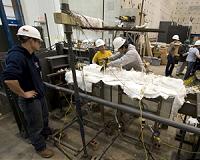| . |  |
. |
Edinburgh, UK (SPX) Nov 30, 2010 A new technique is able to feed data taken from sensors located in burning buildings into computer models so that rescue services can predict how fires will spread. The technology could save firefighters valuable time by giving several minutes of warning on how a fire will develop, helping them to contain the blaze and minimise its impact. Simple sensors - incorporated into smoke alarms, room temperature sensors or CCTV cameras - can measure the temperature and height of a fire. Sophisticated computer models can then convert these into a forecast of the fire's dynamics. This technology, known as Sensor Assisted Fire Fighting, has been developed by researchers at the University of Edinburgh. It allows real-time observation of a fire, with the forecast being constantly updated using information from the sensors. In the event of a significant change in conditions, such as a window breaking, sensor measurements enable the computational model to adapt the forecast. The research, published in Fire Safety Journal, was partially funded by the UK Technology Strategy Board and the European Union. Dr Guillermo Rein of the University's School of Engineering, who supervised the study, said: "Firefighters often have to follow their instincts when tackling a fire. "This technology could give them the extra information they need to consider more options available in handling the emergency, and reduce lost opportunities or unnecessary risks, ultimately saving lives and minimising damage. "However, further research focusing on making the simulation as realistic as possible will be needed before this technology can be put into practice."
Share This Article With Planet Earth
Related Links University of Edinburgh Forest and Wild Fires - News, Science and Technology
 Engineers Test Effects Of Fire On Steel Structures
Engineers Test Effects Of Fire On Steel StructuresWest Lafayette IN (SPX) Nov 22, 2010 Researchers at Purdue University are studying the effects of fire on steel structures, such as buildings and bridges, using a one-of-a-kind heating system and a specialized laboratory for testing large beams and other components. Building fires may reach temperatures of 1,000 degrees Celsius, or more than 1,800 degrees Fahrenheit, said Amit Varma, a Purdue associate professor of civil engi ... read more |
|
| The content herein, unless otherwise known to be public domain, are Copyright 1995-2010 - SpaceDaily. AFP and UPI Wire Stories are copyright Agence France-Presse and United Press International. ESA Portal Reports are copyright European Space Agency. All NASA sourced material is public domain. Additional copyrights may apply in whole or part to other bona fide parties. Advertising does not imply endorsement,agreement or approval of any opinions, statements or information provided by SpaceDaily on any Web page published or hosted by SpaceDaily. Privacy Statement |